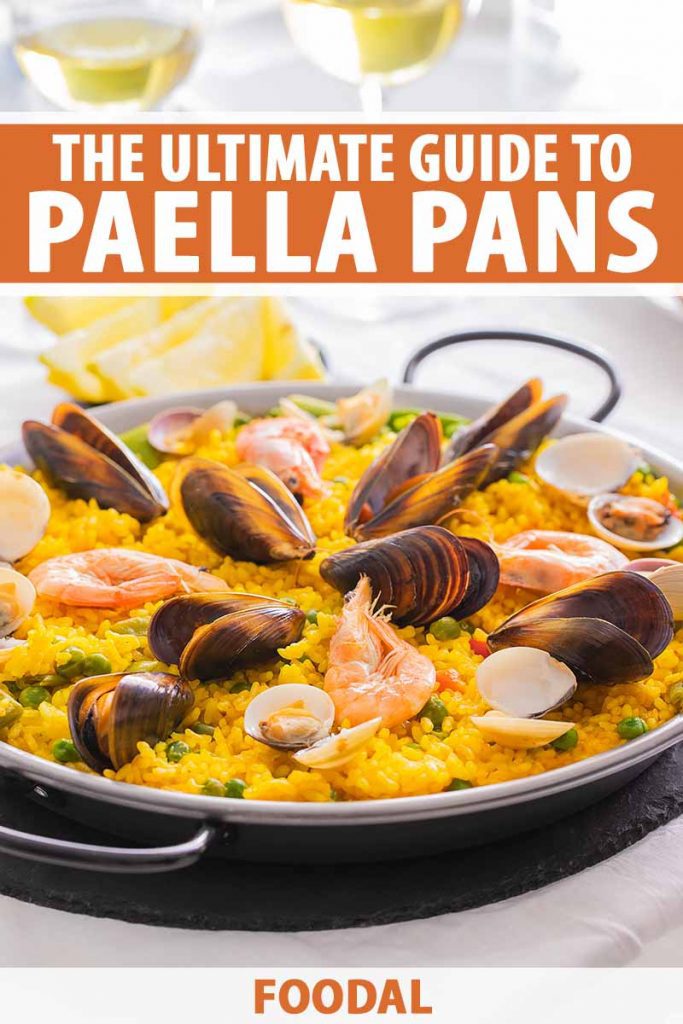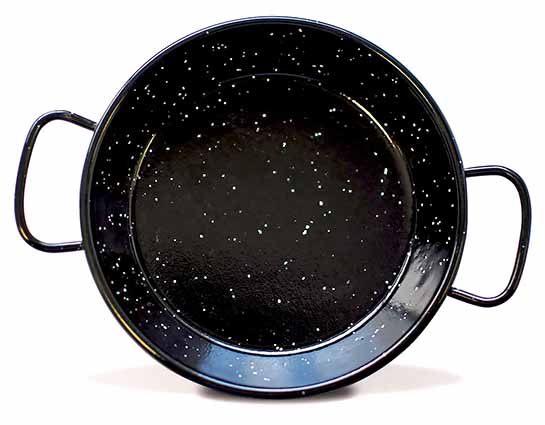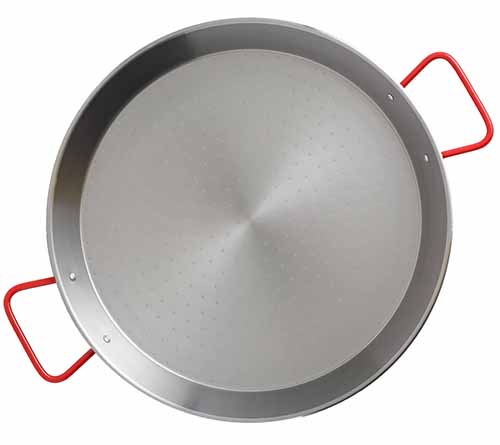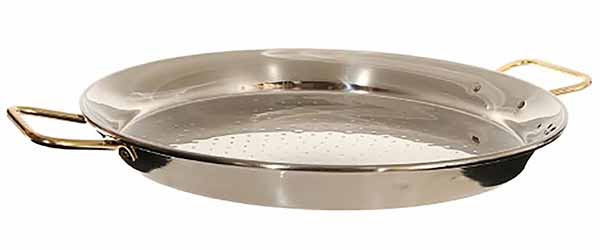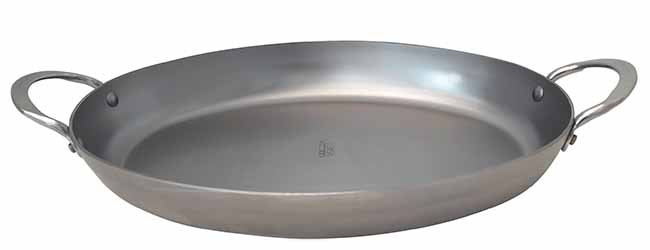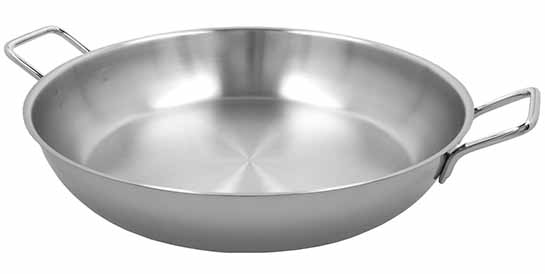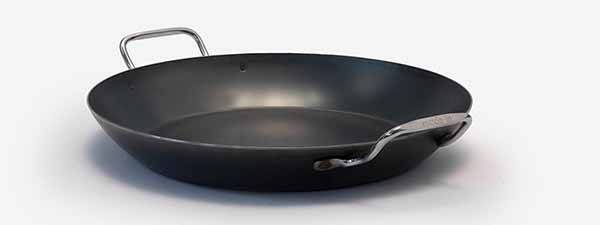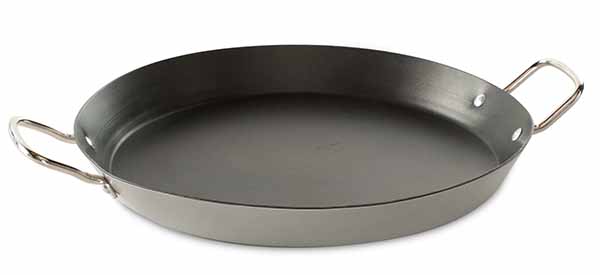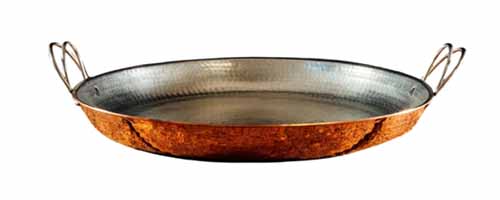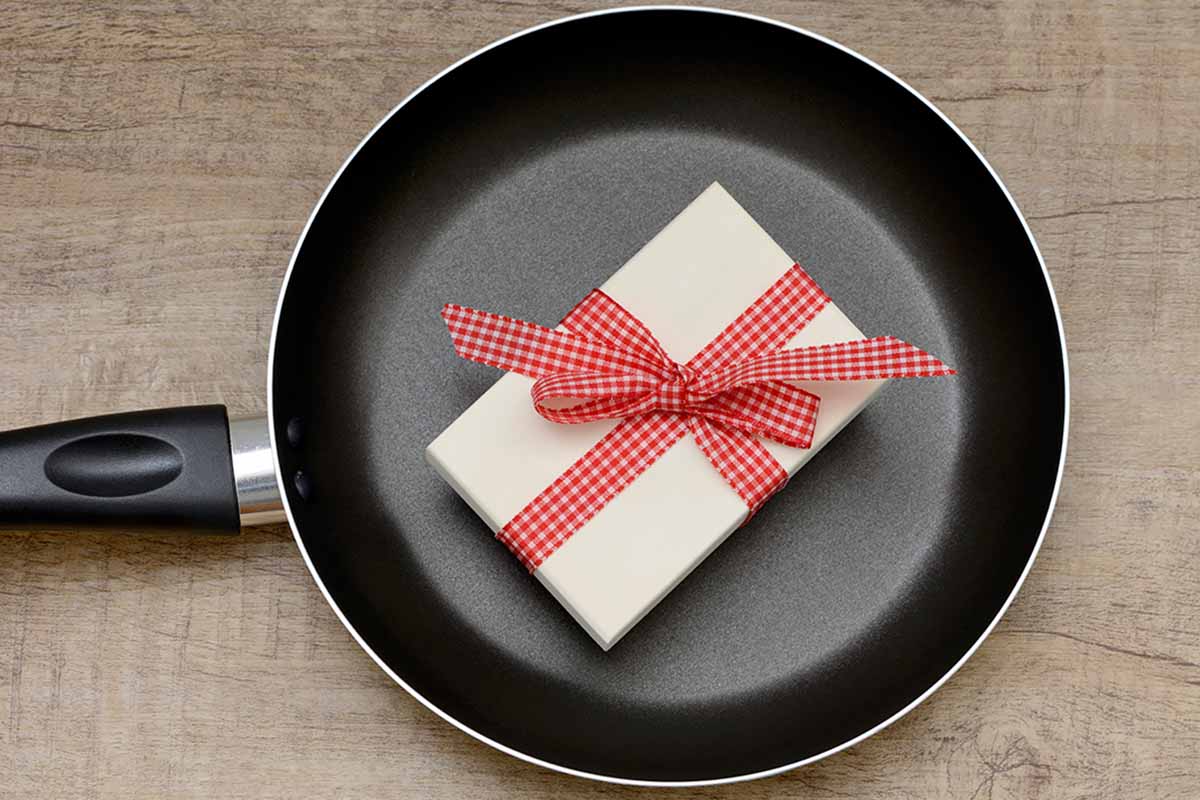If you’ve ever been served paella, the classic Spanish rice dish, it’s more than likely that you’ve seen a paella pan before. And when it comes to buying one of these essential pieces of cookware to make this meal at home, it’s important that you select the right one.
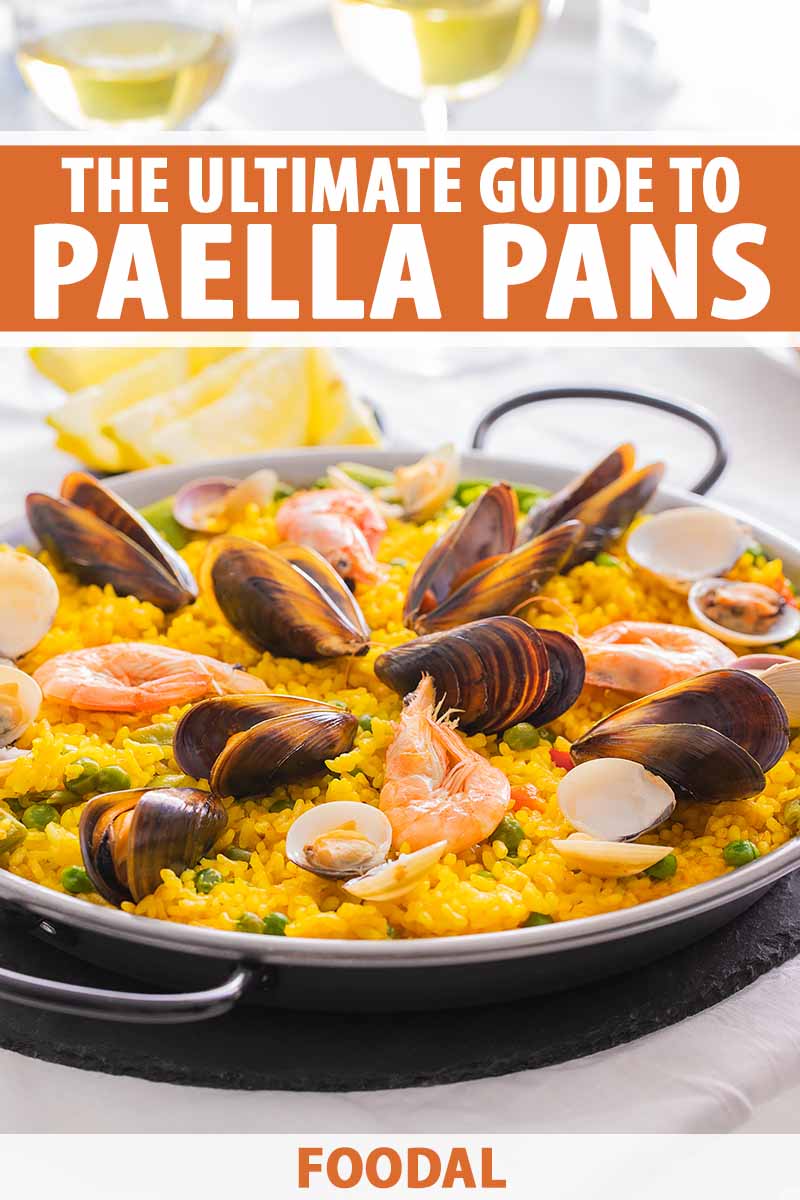
The paella pan is what truly defines this dish.
Why, you ask?
Paella pans are wide and shallow, to maximize surface area. This helps the liquid to evaporate, and that surface contact helps to form a crispy golden crust to provide that delightful crunch and unique flavor that are key elements of this recipe.
Here’s what’s ahead in our guide, starting with a roundup of our top picks.
We follow that up with everything from selection tips and a thorough consideration of the available materials to a few other options for using this new piece of cookware when you’re not in the mood for the Spanish classic – so it won’t be gathering dust on the shelf.
Ready to make some paella? You’re going to need the right gear, so let’s get started.
Foodal’s Ultimate Guide to Paella Pans
- Ancient Cookware Enameled Steel
- Ancient Cookware Garcima Carbon Steel
- Ancient Cookware Garcima Stainless Steel
- De Buyer Mineral B Element Carbon Steel
- Demeyere Resto Stainless Steel
- Garcima Tabarca Carbon Steel with Burner
- Made In Blue Carbon Steel
- Nordic Ware Aluminum
- Sertodo Copper
Our Top 9 Paella Pan Picks
Of all the available options on the market today, these are some of our favorites for cooking paella at home, the ones that we highly recommend taking a look at when you make your selection.

With different chefs, kitchens and heat sources, and styles of dining and entertaining in mind, these options provide a variety of the best models to suit your needs.
You’ll find an economical pick that comes in a variety of sizes, the investment pan that offers top quality at a higher price point, a best-value pan that pairs affordability with decent quality for the occasional cook, and a set that provides a quality pan as well as a burner to cook on.
Other determining factors that helped these options to make it onto our list include looks and all-around quality.
1. Ancient Cookware Enameled Steel
Lightweight and affordable, many cooks love the classic look of black speckled enamel, and it’s a breeze to clean.
These paella pans from Ancient Cookware range in size from a diminutive 4 inches to a substantial 25 inches across, with 9 different options available.
Ancient Cookware Enameled Steel, available on Wayfair
Imported from Spain, you’ll love the extra-wide handles. These can be used for making paella indoors or out on the grill.
The enamel coating can chip with use, so be sure to clean and store it carefully, and avoid using metal utensils that may scratch.
Check current prices and read customer reviews now on Wayfair.
2. Ancient Cookware Garcima Carbon Steel
Fans of the Garcima carbon steel paella pan from Ancient Cookware say it produces a wonderful overall flavor and the crispy layer on the bottom comes out really well. Cleanup is as simple as soaking it after use for a while before you wash it.
Ancient Cookware Garcima Carbon Steel, available on Wayfair
I own the 12-inch version myself, and I would definitely purchase the same one again. It works like a dream every time I use it.
This one is too large for my stovetop, so I use it to cook outside on my grill. It’s made in Spain and this size weighs 2 pounds. But it comes in multiple sizes to meet your needs – eight in total, ranging from 10 to 25 inches in diameter.
Check current prices and reviews now on Wayfair.
3. Ancient Cookware Garcima Stainless Steel
A more affordable 18/8 stainless steel option, the material of this paella pan from the Garcima line resists rusting and discoloration like what you might see in carbon steel cookware.
Ancient Cookware Garcima Stainless Steel, available on Wayfair
Shallow, with sloping sides and a hammered dimpled bottom, this one is expertly designed to produce outstanding results. Made in Spain, it comes in 12 different sizes ranging from 8.5 to a whopping 35 inches in diameter, offering plenty of variety to meet your needs!
The smallest option is very lightweight, at under a pound, while the biggest version weighs a little over 25 pounds.
Check current prices and read customer reviews on Wayfair.
4. De Buyer Mineral B Element Carbon Steel
The Mineral B Element pan from De Buyer has a unique oval shape. Made in France, it’s a carbon steel option that becomes more nonstick the more it is used.
De Buyer Mineral B Element Carbon Steel, available on Wayfair
The handles are made of stainless steel, and it measures 9.5 inches in diameter. This is a more expensive piece that is heavier than some others, weighing about 5 pounds, but it will last a long time and can easily be used for making other recipes as well as paella.
Check current prices on Wayfair.
5. Demeyere Resto Stainless Steel
This 14.8-quart stainless steel paella pan from Demeyere is more of an investment than some of the other top-rated models, and this one is hefty, weighing in at 7 1/4 pounds.
Demeyere Resto Stainless Steel, available on Wayfair
Don’t let the price tag shock you, though. This high-quality piece of cookware offers top-notch performance, and it can be used on all cooking surfaces. It is dishwasher safe, and comes with a lifetime warranty. This one offers good value for the price, as it will last a very long time.
6. Garcima Tabarca Carbon Steel with Burner
This is a fun set from Garcima that not only comes with a Tabarca carbon steel paella pan, but also with a paellero burner.

Garcima Tabarca Carbon Steel with Burner, available on Amazon
Made in Spain, three different size options are available to serve 10, 14, or 18 people, depending on the size of your dinner crowd.
Check current prices and read customer reviews now on Amazon.
7. Made In Blue Carbon Steel
Made In is known for their restaurant-quality cookware that’s made to last, and their blue carbon steel paella and griddle pan will make a worthy addition to your collection whether you already have a cabinet full of Made In items, or you’re new to the brand.
Made In Blue Carbon Steel, available on Made In
With a total diameter of 13.5 inches and a cooking surface that measures 10 by 10.25 inches, this is a sturdy option that can be used outdoors over an open flame, or inside on the stove. It’s also induction compatible, and weighs just under 4.5 pounds.
If you are interested in learning more about this particular product, we have a detailed review of the Made In Blue Carbon Steel paella pan here.
Carbon steel is ideal for getting that perfect socarrat, and you’ll love the sturdy handles when you’re transporting your meal to the table.
8. Nordic Ware Aluminum
Made in the USA, from a brand that so many home cooks already know and trust, this 15-inch model from Nordic Ware is a solid piece of cookware when you’re in the mood for a Spanish meal, and it comes with a 10-year warranty.
Nordic Ware Aluminum, available on Wayfair
With a nonstick coating and cool-touch handles, the cooking surface measures 15 inches in diameter, and it weighs a little over 3 pounds. This option can also be used as a griddle pan on the stove, or outside on the grill.
9. Sertodo Copper
This 14-gauge hammered copper paella pan from Sertodo is an investment piece, without a doubt. But the hammered polish and superior quality make your purchase well worth it.
Sertodo Copper, available on Wayfair
Available in three sizes with widths of 12, 15, or 18 inches, the smallest of these can easily be used to cook other types of dishes as well.
It comes with a limited warranty and is made in Mexico. With a hot-tinned interior, you’ll love the timeless quality of this piece, and your dinner guests will be sure to ooh and ahh. Talk about a beautiful presentation!
How to Choose the Right Paella Pan
Which pan should you select to cook your paella in, when you’re making it at home? There are many different types and sizes available. And it’s of the utmost importance when you are making your chosen variation on this classic recipe that you select the best pan to make it in.
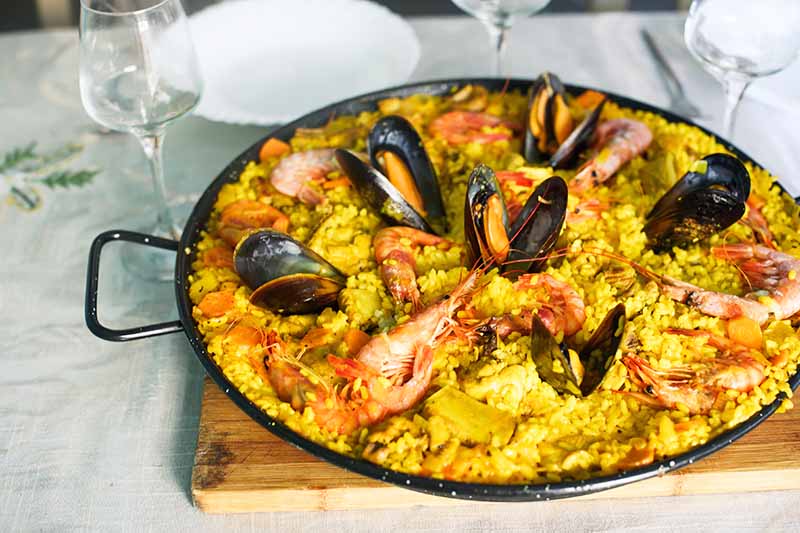
In fact, I’d wager that your choice of cookware here is just as important as your choice of recipe and ingredients.
Yes, it’s really that important!
But every cook’s needs are different, in terms of budget, storage space, size of the crowd you wish to serve all that delicious rice and seafood to, and other factors. We all have different priorities.
This guide is here to help you to wade through the options for making the best paella at home, to determine which is the best piece of cookware available for you, and to help you avoid making a bad investment.
So, let’s take a look at all of the various options that are out there. Each has its pros and cons.
Qualities to Look For
Some pan options are more economical, some are prettier, some are heavier, and some will tend to last longer, or can be used on the heat source of your choice.
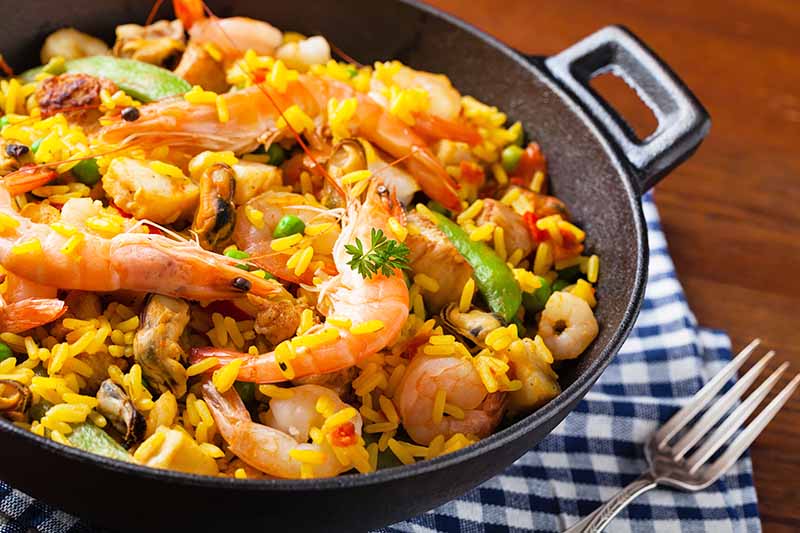
They are all double-handled, of course, and have a flat or slightly convex bottom.
Pro Tip: If you are looking for a way to store your new piece of cookware, particularly if it’s on the large side, consider hanging it from a handle.
First, let’s talk about how many people you would like to serve. Are you looking forward to making big batches of paella, or just a little? Here are some general guidelines:
Most recipes are designed for pans in the 14- to 16-inch range. This generally serves about 6 to 8 people.
If you are scaling up, you can use an 18-inch pan to make up to 12 servings, and a 24-inch pan can make up to 19 servings.

In terms of the amount of rice that this calls for, you will need about 2.5 ounces or 1/3 cup of uncooked rice per person.
Keep in mind, this calculation is assuming everybody will be eating their paella as a meal, and nothing else. If you are serving salad or various side dishes, your guests will of course be eating less paella to make room for these.
I usually serve homemade paella by itself because it is so satisfying on its own, thanks to all the delicious ingredients that it includes.
My #1 Rule of Thumb: Choose the largest piece of cookware available that will work with your heat source.
You might be tempted, but you don’t want to choose a pan that’s bigger than whatever your burner or grill can hold, because the dish will not cook evenly. Paella’s not particularly well-suited to cooking in batches, so you might be stuck if you choose something too small.
For outdoor cooking, try this heavy-duty single-burner outdoor stove from GasOne, available from Amazon. It’s 16 inches across, and you just need to hook it up to a propane tank for use.
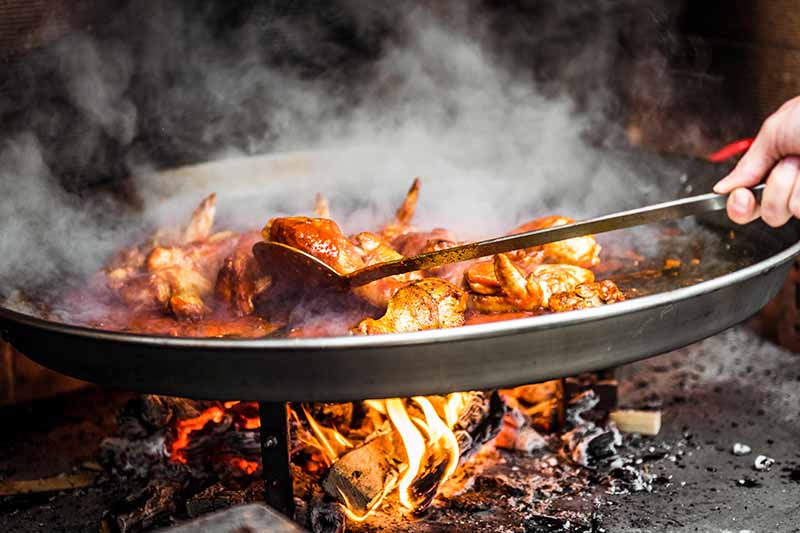
Having said that, the thinner the layer of rice is, the tastier the finished dish will be! Contact with the heat brings out the flavor and the texture of the rice, creating that crispy socarrat that you know and love.
If it’s packed in too thickly, you’re going to miss out on that.
If you are serving a lot of people – more than 12, for example – it may be a good idea to purchase two pieces of cookware instead of aiming to use just one. In this case, you will of course need room on two separate burners.
Again, keep the dimensions of your cooking surface in mind when determining what might work best for you.
Which Size to Choose
Below are standard measurements that you can use as a guideline.
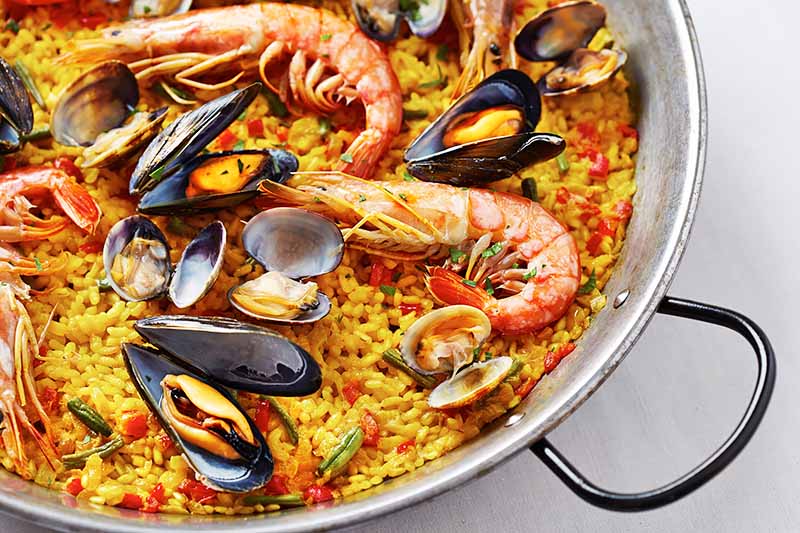
To more accurately ascertain your needs, get out the tape measure to find out how your own personal heat sources measure up.
It’s worth doing this extra step before you make your purchase, to make sure you get the size right.
- Gas paella burner – Up to 40 inches wide
- Outdoor grill – About 26 inches wide
- Oven – Typically 17 to 18 inches wide
- Stovetop – Typically 20 to 22 inches wide
Materials and Benefits of Each Type
Now it’s time to consider the pros and cons of each type of paella pan. Not sure which type to choose? We can help!
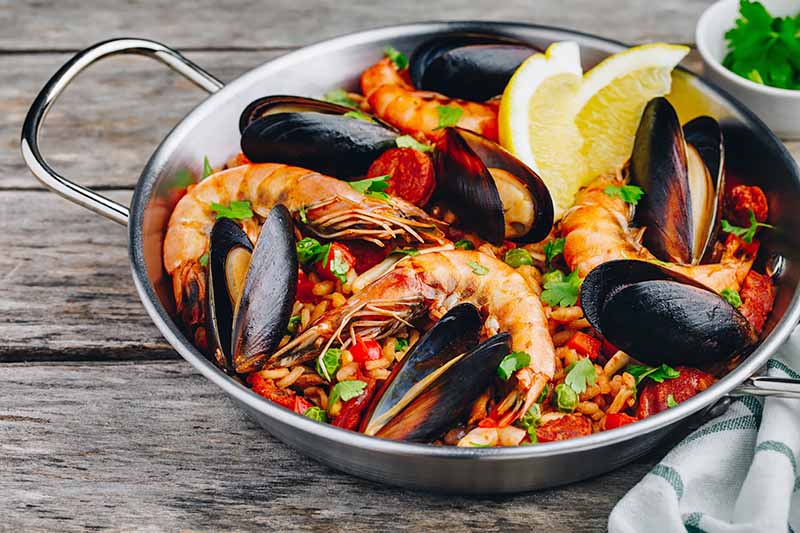
You can cook on the grill or over an open fire, in the oven, or on the stovetop, depending on which style you choose.
Again, these cooking vessels are classically wide and shallow. Some will dip slightly in the center, so the oil can collect there for sauteing.
Listed here for your convenience are the various types of materials that may be used in cookware intended to to prepare paella, with the unique attributes of each, to help you to determine which variety to purchase.
Aluminum
Aluminum is great for thermal conductivity, and it’s affordable and very lightweight.
To ensure you are selecting a safe, efficient paella pan, make sure the cookware that you choose has been anodized or clad in a nonreactive material such as stainless steel or a nonstick coating. This will prevent aluminum from leaching into or reacting with foods, and helps with easier cleanup as well.
Black Carbon Steel
Thick and heavy, this material heats up quickly and distributes heat evenly. You can also use it to cook other foods such as vegetables, or even steaks.
This type of carbon steel pan has undergone a surface-hardening treatment to prevent rust. Plus, it’s pretty enough to go from your cooking surface straight to the table.
Blue carbon steel is treated with a different type of surface-hardening material, making it look blue in appearance instead of shiny silver like stainless.
Carbon steel is the most traditional material used for this type of pan, and it conducts heat very quickly, which imparts a nice flavor to the paella because it easily sears foods and allows for the caramelization of the rice.
As a potential downside, you must take precautions to be sure it does not rust. This means you must dry it thoroughly after each use, and oil it before storing. This isn’t a lot of work really, so I wouldn’t worry too much about that if you like this material and potential cleaning issues are holding you back.
This type is also very economical. Look for a thinner rather than a thicker bottom, so it will heat up fast and cool down quickly as well.
Many cooks seem to prefer the large, classic carbon steel versions. This is because the larger, flat, and wide cooking surface creates a shallow bed of rice. Because it is shallow, this will allow for the formation of socarrat, which is a delicious caramelized crust, exactly what makes this Spanish dish so delicious.
Ceramic/Enamel Coated Cast Iron
This is another classic material for cooking paella, and it provides even and uniform heat without hot spots. A good cast iron pan can be used on the grill, on the stove, or in the oven.
Since this material retains heat, you can cook on low to medium heat and the paella will stay warm for a longer amount of time than if you made it in a different type of pan. However, iron is not a good heat conductor, so note that this type does take longer to heat up than other materials.
These often have an enamel finish, which makes them durable, easy to clean, and very attractive on your table when serving guests.
In addition, as long as the surface is smooth, they will not scratch glass flat-top stoves.
Copper
An excellent conductor of heat, copper cookware of this type is usually manufactured with a dimpled surface that helps to distribute the heat evenly.

One of the things I like best about copper is its beauty, and it also cools quickly after being removed from the heat source, so you can quickly place it on the table.
A potential downside is that these tend to be the most expensive, but I feel this is worth it in the long run for all the benefits they provide. If you treat them well, they should last a very long time.
Copper poses a slight risk of toxicity, especially when used to cook acidic foods such as tomatoes. But unlike aluminum, copper is an essential mineral and ingesting it is beneficial in small doses. This makes the risk of cooking with copper a controversial topic, so you will need to make the call on this one for yourself.
Copper cookware is often lined with another material, such as stainless steel or tin, keeping the copper from coming into direct contact with your food.
Copper and Stainless Steel
This combination metal heats fast and evenly, and it will not warp. Durable and layered with a non-reactive stainless steel interior and a copper core, cooking on stainless preserves the taste and nutritional quality of the food, and it is easy to clean.
Copper and steel cookware can be used on gas, electric, and halogen stovetops, or in the oven.
Double Gauge Steel
Heavy-duty and long lasting, this material must be washed by hand, and you must season it with oil for storage to prevent rust.
These are often twice as heavy as cookware made of other materials, but this heft adds resistance to warping and improves heat distribution. An added bonus is that this type of paella pan will keep the rice warm throughout the duration of your meal.
Enamel-Coated Steel
Enameled steel starts with the same material as the carbon steel variety, often coated with a speckled black enamel finish. These are very economical, and most of the top-rated paella pans on the market today are of this variety.
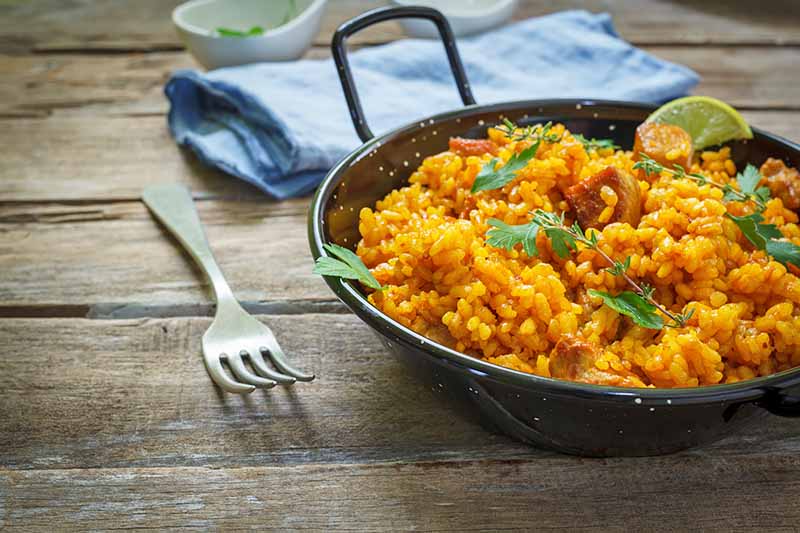
Another plus is that enamel-coated steel will not rust. The coating will chip if you bang them around a lot, but there’s no real harm done if they have a few chips here and there. In fact, I think the rustic look of a well-used pan is nice sometimes, as proof of your hard work in the kitchen!
Nonetheless, aim to store these with care and use soft utensils that won’t scratch, to protect the enamel coating.
Polished Carbon Steel
Another traditional option often used in Spain, this material is very thin, transmitting heat very well to facilitate quick cooking and cooling. Plus, it offers the convenience of being dishwasher safe.
You’ll often see these with a dimpled and slightly curved bottom, which gives the rice varying degrees of crunchiness, accentuating the lovely texture and flavor of the grain.
Stainless Steel Tri-Ply Bonded
Stainless with an aluminum core, this material should last a lifetime. Though it doesn’t conduct heat as well as copper, it still distributes heat very well.

Dishwasher and freezer safe, hand washing is recommended. The tough surface is compatible with all traditional ranges as well as induction cooktops.
Stainless Steel
Standard stainless steel paella pans are bright, shiny, beautiful to look at, and easy to take care of – but they tend to be more costly than some options. Commonly used in all types of cookware, this material is also rust-proof.
What Else Can I Use My Paella Pan For?
Worried about purchasing a new piece of cookware that only has one specific use? Think again, because a paella pan can be used for other kinds of cooking that require a wide, flat surface as well.

You can use it for searing steaks, chicken, fish, and roasts. It can be used as a griddle for making pancakes and bacon. You can even use it to stir fry in lieu of a wok. Don’t forget to take it with you camping as well.
Buen provecho! Be sure to check out our seafood paella recipe once you get your pan so you can make your own at home like a pro.
Which model will you choose, or do you already have a paella pan that you love? Tell us in the comments below, and let us know if you have a favorite we didn’t include on our list!
Looking for even more of our top-pick cookware favorites to add to your collection? Read these reviews next:
- Made In Blue Carbon Steel Wok: A Slick Pan for Any Stir Fry Enthusiast
- De Buyer’s Prima Matera: Your Answer for Cooking with Copper on Induction Stoves
- Which All-Clad Collection Is Right for Your Kitchen?
© Ask the Experts, LLC. ALL RIGHTS RESERVED. See our TOS for more details. Significantly revised and expanded from an article originally written by Lori Jo Hendrix. With additional writing and editing by Allison Sidhu. Credited photos via Wayfair, Amazon, Made In. Uncredited photos via Shutterstock.
About Meghan Yager
Meghan Yager is a food addict turned food and travel writer with a love for creating uncomplicated, gourmet recipes and devouring anything the world serves up. As the author of the food and travel blog Cake 'n Knife, Meghan focuses on unique foodie experiences from around the world to right at home in your own kitchen.

